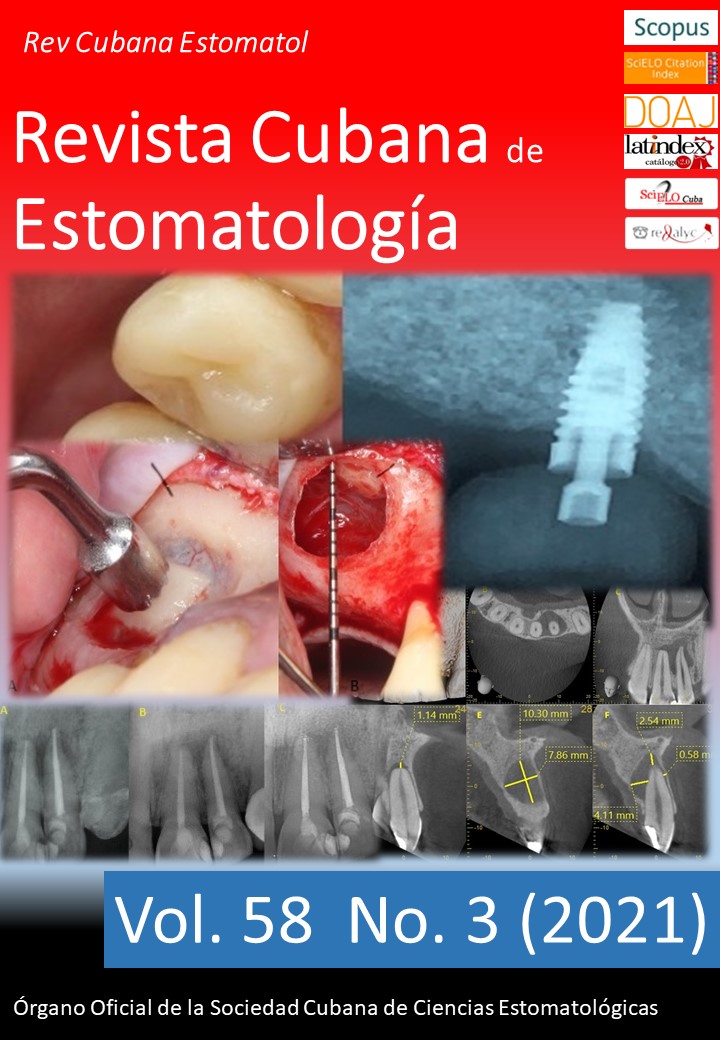Lichen planus pigmentosus in oral cavity
Keywords:
Oral Lichen Planus, Hyperpigmentation, Oral Pathology.Abstract
Introduction: Pigment lichen planus is an autoimmune lesion of unknown etiology, with preference for middle-aged women, which mainly affects the face and neck, being rare in the oral cavity. Objective: To report a case of pigment lichen planus in the oral cavity, with emphasis on its clinical and histopathological characteristics. Case report: 21 years old woman, black, who came to the service complaining about a spot in the oral cavity. The lesions presented a month of evolution, radial growth and no painful symptoms. They consisted of blackened plates of regular contour with whitish stretch marks on their periphery, rounded shape, sharp edges, on bilateral jugular mucosa, which measured approximately 13 mm on the left side and 25 mm on the right. After the incisional biopsy and histopathological analysis, the suspicion of oral pigment lichen planus was confirmed. The proposed treatment for the lesions was conservative through strict clinical follow-up. Conclusion: The importance and difficulty of the diagnosis of pigment lichen planus is emphasized, especially due to its low occurrence in the oral cavity and its atypical clinical characteristics and similar to other oral lesions. In this context, the relevance of the histopathological examination is ratified and the need for further studies to clarify the etiological factors involved in this pathology is highlighted.Downloads
References
Cheng YSL, Gould A, Kurago Z, Fantasia J, Muller S. Diagnosis of oral lichen planus: a position paper of the American Academy of Oral and Maxillofacial Pathology. Oral Surg Oral Med Oral Pathol Oral Radiol. 2016;122:332–54.
Bhutani LK, Bedi TR, Pandhi RK, Nayak NC. Lichen planus pigmentosus. Dermatologica. 1974;149:43–50.
Peralta R, Pazos M, Sabban EC, Schroh R, Cabo H. Liquen plano pigmentoso invertido Reporte del primer caso pediátrico y revisión de la literatura. Arch Argent Dermatol. 2015;65:189–94.
Gorouhi F, Davari P, Fazel N. Cutaneous and mucosal lichen planus: a comprehensive review of clinical subtypes, risk factors, diagnosis, and prognosis. Sci World J. 2014;2014:1–22.
El-Naggar AK, Chan JKC, Grandis JR, Takata T, Slootweg PJ. WHO classification of tumours of the head and neck. 4th ed. Lyon: IARC Press; 2017.
Boñar-Alvarez P, Pérez Sayáns M, Garcia-Garcia A, Chamorro-Petronacci C, Gándara-Vila P, Luces-González R, et al. Correlation between clinical and pathological features of oral lichen planus. Medicine (Baltimore). 2019;98:1–5.
Gonzalez-Moles MA, Scully C, Gil-Montoya JA. Oral lichen planus: Controversies surrounding malignant transformation. Oral Dis. 2008;14:229–43.
Wickham LF. Sur unsigne pathognomoniquedelichen du Wilson (lichen plan) stries et punctuations grisatres. Ann Dermatol Syph. 1895;6:17–20.
Goncalves ABF, Missio DM, Santos NA da SQ dos, Gonçalves PPF, Issa MC, Rachael M. Líquen plano pigmentoso com apresentação atípica simulando uma máscara de dormir. Rev Da Soc Port Dermatologia e Venereol. 2018;76:71–4.
Hartanto FK, Kallarakal TG. Pigmented Oral Lichen Planus: A Case Report. Sci Dent J. 2017;1:11–6.
Al-Mutairi N, El-Khalawany M. Clinicopathological characteristics of lichen planus pigmentosus and its response to tacrolimus ointment: An open label, non-randomized, prospective study: original article. J Eur Acad Dermatology Venereol. 2010;24:535–40.
Alrashdan MS, Cirillo N, McCullough M. Oral lichen planus: a literature review and update. Arch Dermatol Res. 2016;308:539–51.
Chitturi RT, Sindhuja P, Parameswar RA, Nirmal RM, Reddy BVR, Dineshshankar J, et al. A clinical study on oral lichen planus with special emphasis on hyperpigmentation. J Pharm Bioallied Sci. 2015;7:S495-8.
Neville BW, Damm DD, Allen CM, Bouquot JE. Patologia Oral e Maxilofacial. 3rd ed. Rio de Janeiro: Saunders Elsevier; 2009.
Ghosh A, Coondoo A. Lichen planus pigmentosus: The controversial consensus. Indian J Dermatol. 2016;61:482.
Bhutani LK, George M, Bhate SM. Vitamin A in the treatment of lichen planus pigmentosus. Br J Dermatol. 1979;100:473–4.
Published
How to Cite
Issue
Section
License
Authors retain all rights to their works, which they can reproduce and distribute as long as they cite the primary source of publication.
The Rev Cubana Estomatol is subject to the Creative Commons Attribution-Non-Commercial 4.0 International License (CC BY-NC 4.0) and follows the publication model of SciELO Publishing Schema (SciELO PS) for publication in XML format.
You are free to:
- Share — copy and redistribute the material in any medium or format.
- Adapt — remix, transform, and build upon the material.
The licensor cannot revoke these freedoms as long as you follow the license terms.
Under the following terms:
Attribution — You must give appropriate credit, provide a link to the license, and indicate if changes were made. You may do so in any reasonable manner, but not in any way that suggests the licensor endorses you or your use.
- NonCommercial — You may not use the material for commercial purposes.
No additional restrictions — You may not apply legal terms or technological measures that legally restrict others from doing anything the license permits.
Notices:
- You do not have to comply with the license for elements of the material in the public domain or where your use is permitted by an applicable exception or limitation.
- No warranties are given. The license may not give you all of the permissions necessary for your intended use. For example, other rights such as publicity, privacy, or moral rights may limit how you use the material.


